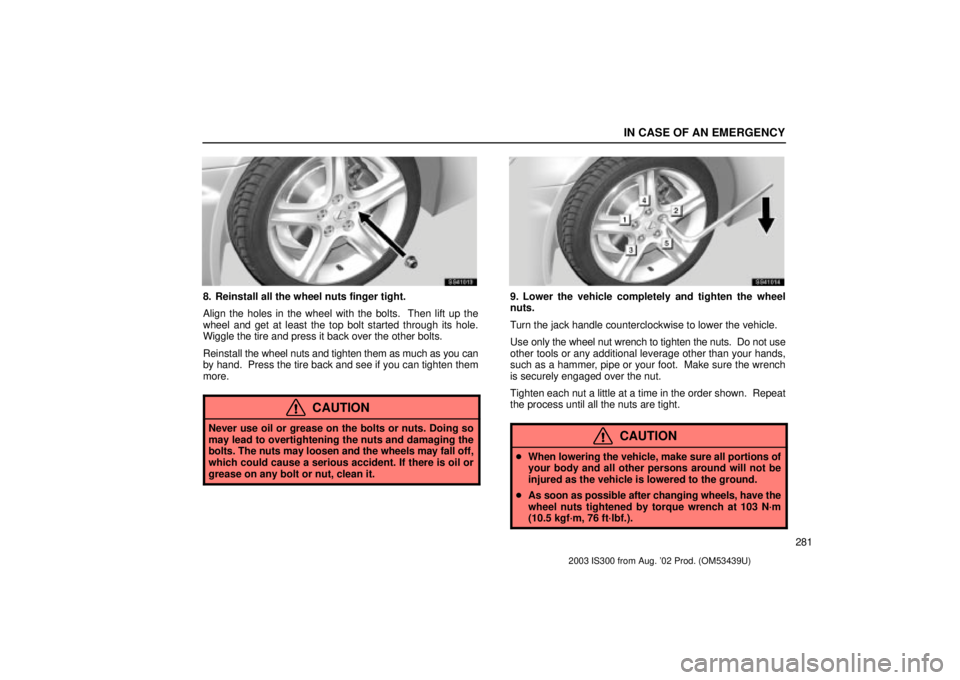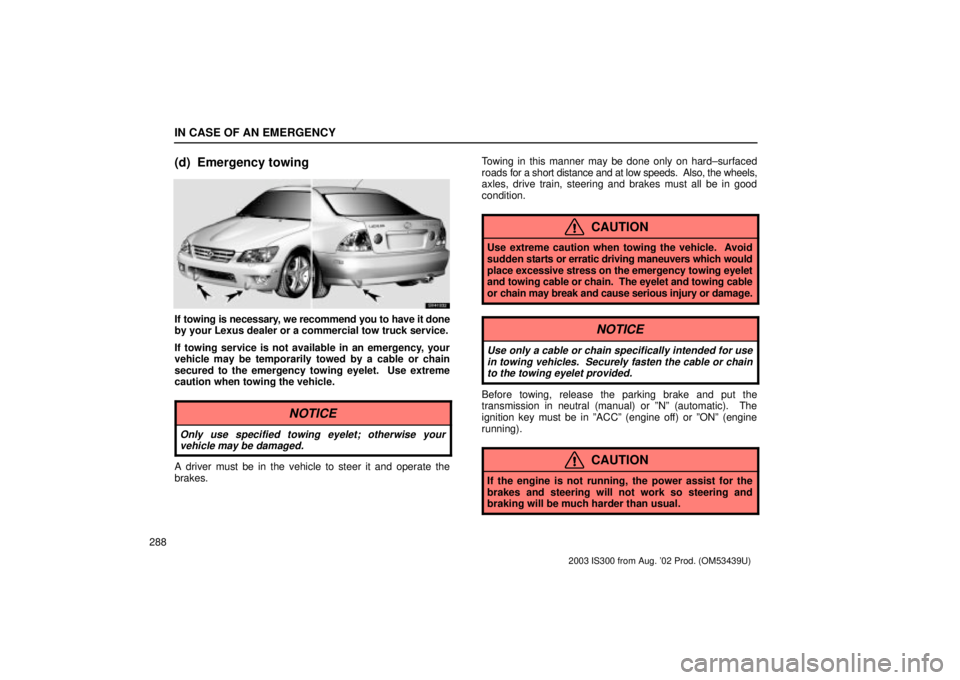Page 250 of 389
STARTING AND DRIVING
237
(e) Backing up
SV31025
� 1Brake pedal 2ºRº (Reverse) position
1. Bring the vehicle to a complete stop.
2. With the brake pedal held down with your foot, shift the
selector lever to the ºRº position.
NOTICE
Never shift into reverse while the vehicle is moving.
(f) Parking
SV31026
� 1Brake pedal 2Parking brake lever
3ºPº (Park) position
1. Bring the vehicle to a complete stop.
2. Pull the parking brake lever up fully to securely apply the
parking brake.
3. With the brake pedal held down with your foot, shift the
selector lever to the ºPº position.
CAUTION
Never attempt to move the selector lever into ºPº under
any circumstances while the vehicle is moving. Serious
mechanical damage and loss of vehicle control may
result.
2003 IS300 from Aug. '02 Prod. (OM53439U)
Page 273 of 389

DRIVING TIPS
260
�Do not continue normal driving when the brakes are
wet. If they are wet, your vehicle will require a longer
stopping distance, and it may pull to one side when
the brakes are applied. Also, the parking brake will
not hold the vehicle securely.WINTER DRIVING TIPS
Make sure you have a proper freeze protection of engine
coolant.
Your coolant must contain ethylene±glycol type coolant for a
proper corrosion protection of aluminum components. Use
ºToyota Genuine Long Life Coolantº or equivalent. See
ºChecking the engine coolant levelº on page 319 for
instructions.
NOTICE
Do not use alcohol type antifreeze or plain water alone.
When it is extremely cold, we recommend to use 60% solution
for your Lexus, to provide protection down to about ±50 �C
(±58 �F). Do not use more than 70% solution for better coolant
performance.
Check the condition of the battery and cables.
Cold temperatures reduce the capacity of any battery, so it
must be in top shape to provide enough power for winter
starting. Page 348 tells you how to visually inspect the battery.
Your Lexus dealer and most service stations will be pleased to
check the battery charge level.
Make sure the engine oil viscosity is suitable for the cold
weather.
See page 317 for recommended viscosity. Leaving a heavy
summer oil in your vehicle during winter months may cause
harder starting. If you are not sure about which oil to use, call
your Lexus dealer ± they will be pleased to help.
2003 IS300 from Aug. '02 Prod. (OM53439U)
Page 287 of 389
IN CASE OF AN EMERGENCY
274
Access to spare tire (SportCross)
SV41029
1. Pull up the deck board.
SV41030
2. Take off the hook at the rear of the deck board.
3. Lift up the back side of the board and secure the board
by hooking it at the top of the back door opening with the
hook at the edge of the strap.
Make sure the board is secured and does not fall down.
2003 IS300 from Aug. '02 Prod. (OM53439U)
Page 290 of 389
IN CASE OF AN EMERGENCY
277
SS41005
� 1Joint
2When removing the jack, turn the joint by hand in the
ºcontractº direction until the jack is free.
3 When storing, turn the joint by hand in the ºexpandº
direction u ntil the jack is firmly secured to prevent it from
flying forward during a collision or sudden braking.
SV41028
To remove the spare tire:
1Remove the tool tray
2Loosen the bolt and remove it.
When storing the spare tire, place it with the inner side of the
wheel facing up. Then bolt the tire in place and install the tool
tray to prevent the tire from flying forward during a collision or
sudden braking.
2003 IS300 from Aug. '02 Prod. (OM53439U)
Page 294 of 389

IN CASE OF AN EMERGENCY
281
SS41013
8. Reinstall all the wheel nuts finger tight.
Align the holes in the wheel with the bolts. Then lift up the
wheel and get at least the top bolt started through its hole.
Wiggle the tire and press it back over the other bolts.
Reinstall the wheel nuts and tighten them as much as you can
by hand. Press the tire back and see if you can tighten them
more.
CAUTION
Never use oil or grease on the bolts or nuts. Doing so
may lead to overtightening the nuts and damaging the
bolts. The nuts may loosen and the wheels may fall off,
which could cause a serious accident. If there is oil or
grease on any bolt or nut, clean it.
SS41014
9. Lower the vehicle completely and tighten the wheel
nuts.
Turn the jack handle counterclockwise to lower the vehicle.
Use only the wheel nut wrench to tighten the nuts. Do not use
other tools or any additional leverage other than your hands,
such as a hammer, pipe or your foot. Make sure the wrench
is securely engaged over the nut.
Tighten each nut a little at a time in the order shown. Repeat
the process until all the nuts are tight.
CAUTION
� When lowering the vehicle, make sure all portions of
your body and all other persons around will not be
injured as the vehicle is lowered to the ground.
� As soon as possible after changing wheels, have the
wheel nuts tightened by torque wrench at 103 N´m
(10.5 kgf´m, 76 ft´lbf.).
2003 IS300 from Aug. '02 Prod. (OM53439U)
Page 295 of 389

IN CASE OF AN EMERGENCY
282
SL41002
10. Reinstall the wheel ornament.
Put the wheel ornament into position and then tap it firmly with
the side or heel of your hand to snap it into place.
CAUTION
Take due care in handling the ornament to avoid
unexpected personal injury.
11. After changing the wheel, check the air pressure of the
replaced tire. Stow all the tools, jack and flat tire securely.
If the pressure of the replaced tire is low, drive slowly to the
nearest service station and fill to the correct pressure.
Do not forget to reinstall the tire valve cap as dirt and moisture
could get into the valve core and possibly cause air leakage.
If the cap is missing, put a new one on as soon as possible.
This is the same procedure for changing or rotating your tires.
CAUTION
� When reinstalling a standard tire, take due care in
handling the ornament to avoid unexpected personal
injury.
� Before driving, make sure all the tools, jack and flat
tire are securely in place in their storage location to
reduce the possibility of personal injury during a
collision or sudden braking.
2003 IS300 from Aug. '02 Prod. (OM53439U)
Page 301 of 389

IN CASE OF AN EMERGENCY
288
(d) Emergency towing
SV41032
If towing is necessary, we recommend you to have it done
by your Lexus dealer or a commercial tow truck service.
If towing service is not available in an emergency, your
vehicle may be temporarily towed by a cable or chain
secured to the emergency towing eyelet. Use extreme
caution when towing the vehicle.
NOTICE
Only use specified towing eyelet; otherwise yourvehicle may be damaged.
A driver must be in the vehicle to steer it and operate the
brakes. Towing in this manner may be done only on hard±surfaced
roads
for a short distance and at low speeds. Also, the wheels,
axles, drive train, steering and brakes must all be in good
condition.
CAUTION
Use extreme caution when towing the vehicle. Avoid
sudden starts or erratic driving maneuvers which would
place excessive stress on the emergency towing eyelet
and towing cable or chain. The eyelet and towing cable
or chain may break and cause serious injury or damage.
NOTICE
Use only a cable or chain specifically intended for use in towing vehicles. Securely fasten the cable or chainto the towing eyelet provided.
Before towing, release the parking brake and put the
transmission in neutral (manual) or ºNº (automatic). The
ignition key must be in ºACCº (engine off) or ºONº (engine
running).
CAUTION
If the engine is not running, the power assist for the
brakes and steering will not work so steering and
braking will be much harder than usual.
2003 IS300 from Aug. '02 Prod. (OM53439U)
Page 307 of 389

MAINTENANCE
294Tire rotation
Rotate the tires according to the maintenance schedule. (For
scheduled maintenance information, please refer to the
ªOwner's Manual Supplementº or ªScheduled Maintenanceº.)
See page 333 for additional information.
Fluid leaks
Check under
neath for leaking fuel, oil, water or other fluid after
the vehicle has been parked for a while. If you smell fuel fumes
or notice any leak, have the cause found and corrected
immediately.
Doors and engine hood
Check that all doors, including trunk lid or back door, operate
smoothly and all latches lock securely. Make sure the engine
hood secondary latch secures the hood when the primary latch
is released.
Vehicle interior
Items listed below should be checked regularly, e.g. while
performing periodic services, cleaning the vehicle, etc.
Lights
Make sure the headlight, stop lights, tail lights, turn signal
lights, and other lights are working. Check headlight aim.
Service reminder indicators and warning buzzers
Check that all service reminder indicators and warning
buzzers function properly. Steering wheel
Check that it has the specified free play. Be alert for changes
in steering condition, such as hard steering, excessive free
play or strange noise.
Seats
Check that all front seat controls such as seat adjusters,
seatback recliner, etc. operate smoothly. Ch
eck that the head
restraints move up and down smoothly and that the locks hold
securely in any latched position. For folding±down rear
seatbacks, check that the latches lock securely.
Seat belts
Check that the seat belt system such as buckles, retractors
and anchors operate properly and smoothly. Make sure the
belt webbing is not cut, frayed, worn or damaged.
Accelerator pedal
Check the pedal for smooth operation and uneven pedal ef fort
or catching.
Clutch pedal
Check the pedal for smooth operation.
Brake pedal
Check the pedal for smooth operation and the proper
clearance and free play. Check the brake booster function.
Brakes
At a safe place, check that the brakes do not pull to one side
when applied.
2003 IS300 from Aug. '02 Prod. (OM53439U)